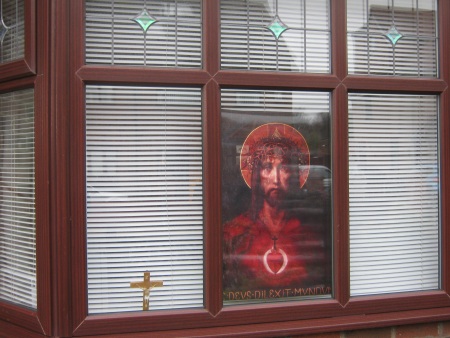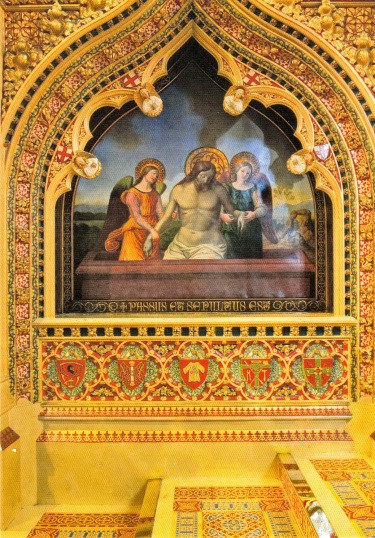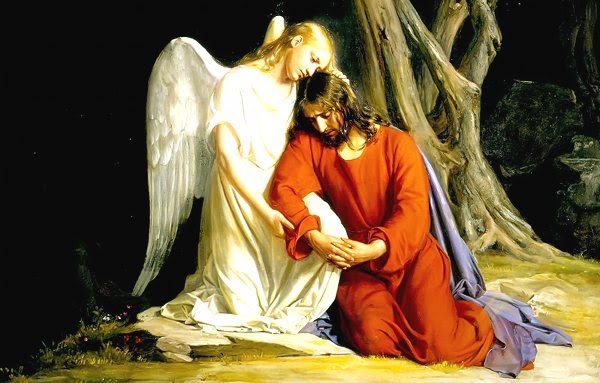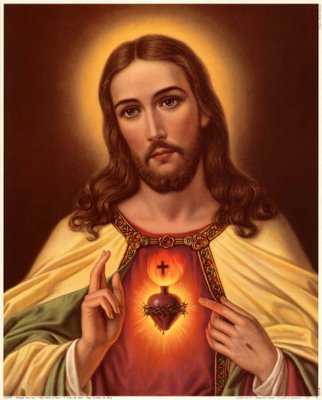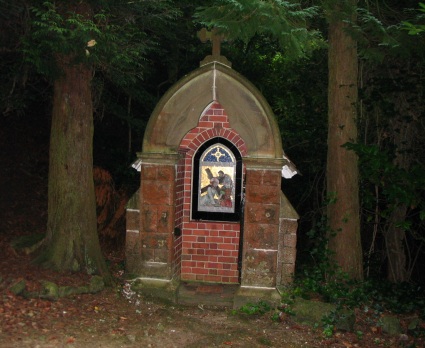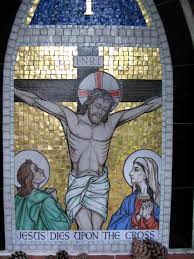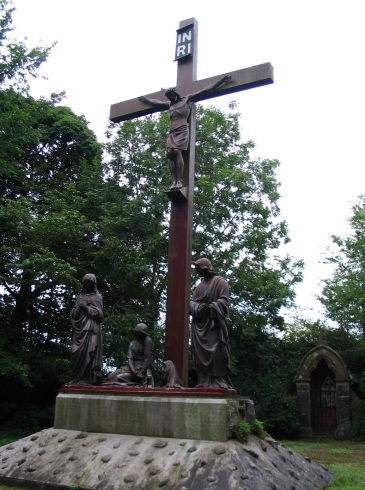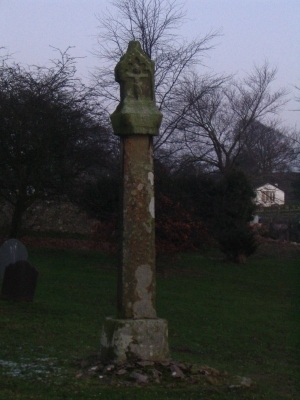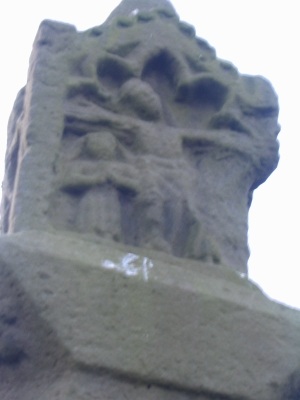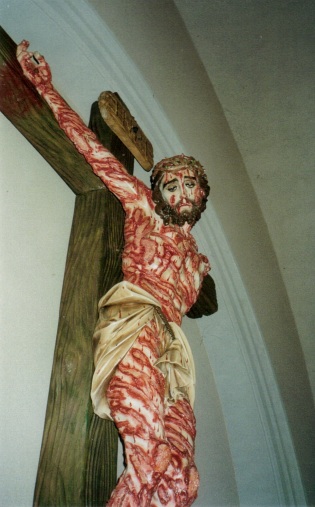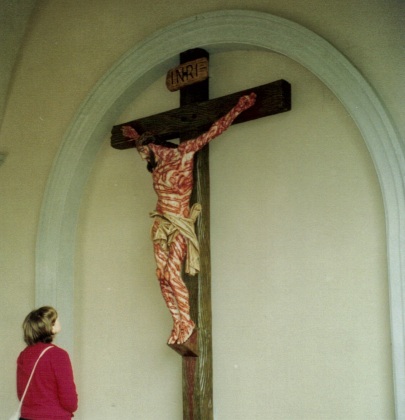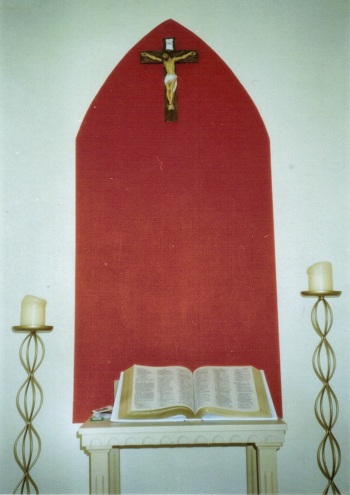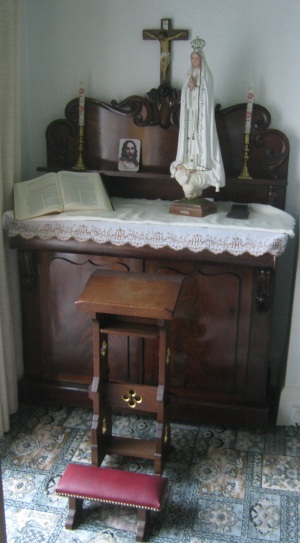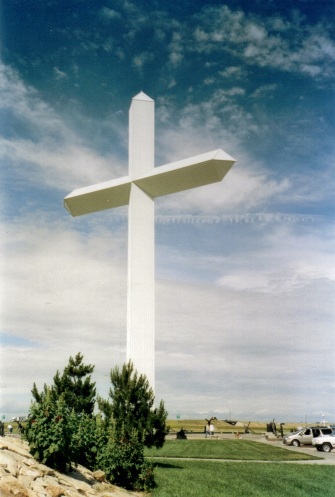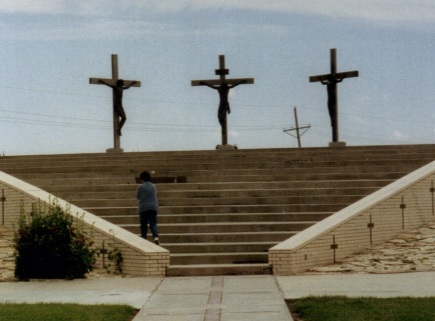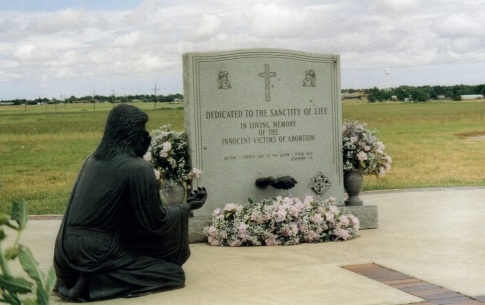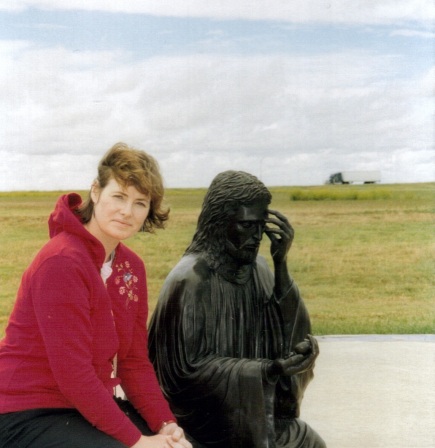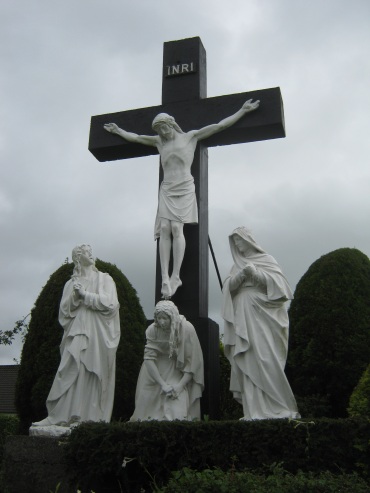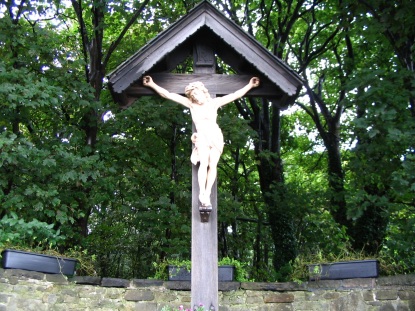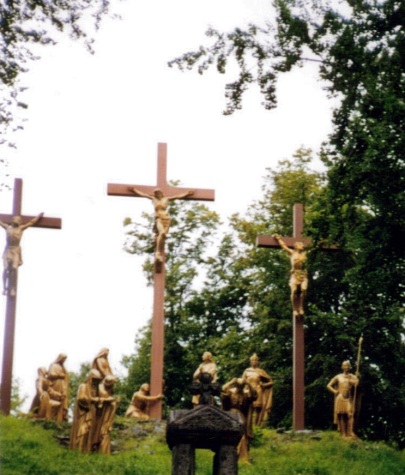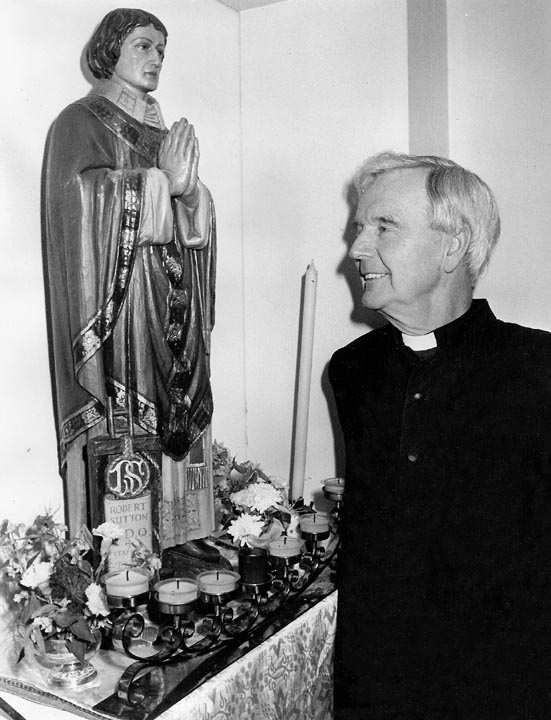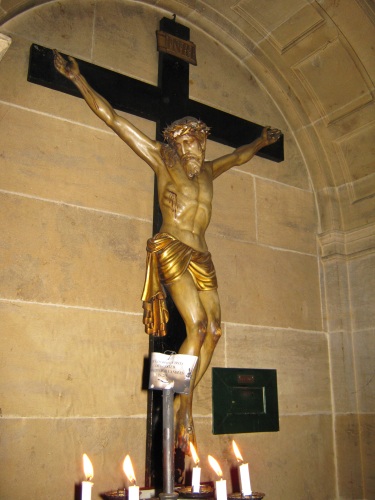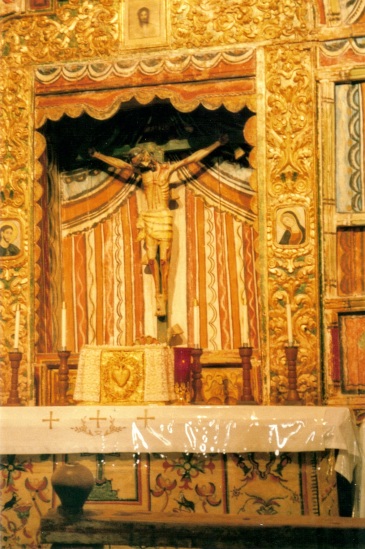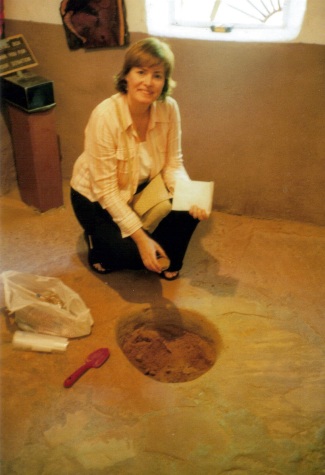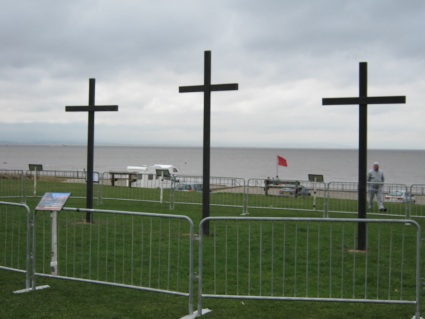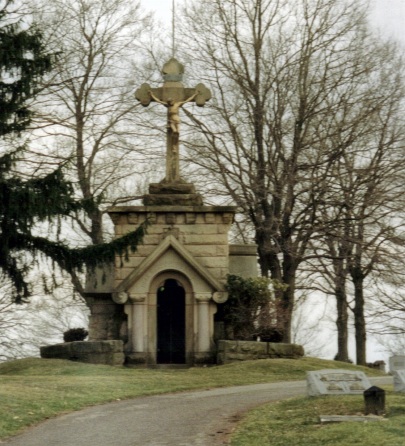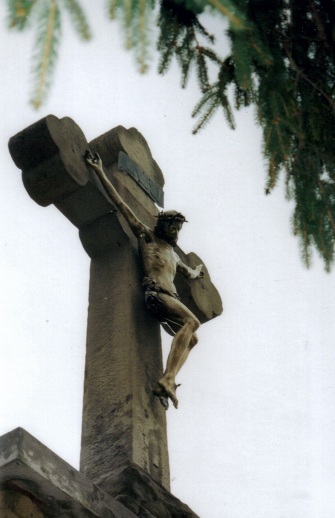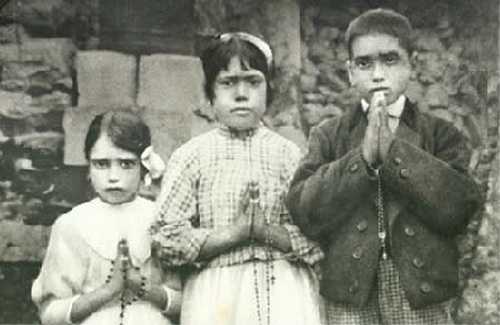Holy Saturday 2016 - Prayer and Recollection near to Jesus in the Tomb
 Torch of The Faith News on Saturday 26 March 2016 - 12:01:28 | by admin
Torch of The Faith News on Saturday 26 March 2016 - 12:01:28 | by admin
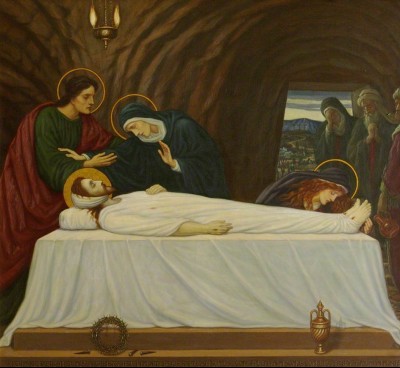
A reflection for Holy Saturday by Fr. Gabriel of St. Mary Magdalen, O.C.D.
''In peace in the selfsame I will sleep, and I will rest.'' These opening words of Matins of Holy Saturday refer to the peace of the tomb, where after so many torments, the sacred Body of Jesus rests. Indeed, this day is meant to be one of recollection in silence and prayer beside the sepulchre of the Lord.
After the death of Jesus, frightened by the earthquake and the darkness, all had left Calvary except the little group of faithful ones: Our Lady and St. John, who were never away from the Cross, and Mary Magdalene, and the other pious women who ''had followed Jesus from Galilee ministering unto Him'' (Mt:27:55). Although Our Lord had died, they could not tear themselves away from Him, their adored Master, the object of all their love and hope. It was their love that kept them near the lifeless Body. This is a sign of real fidelity, to persevere even in the darkest and most painful moments, when all seems lost, and when a friend, instead of triumphing, is reduced to defeat and profound humiliation. It is easy to be faithful to God when everything goes smoothly, when His cause triumphs; but to be equally faithful in the hour of darkness, when, for a time, He permits evil to get the upper hand, when everything that is good and holy seems to be swept away and irrevocably lost - this is hard, but it is the most authentic proof of real love.
Two disciples, Joseph of Arimathea and Nicodemus, took charge of the burial. The sacred Body was taken down from the Cross, wrapped in a sheet with spices, and laid ''in a new tomb'' which Joseph ''had hewed out in a rock (for himself)'' (Mt: 27:60). Together with Mary, who must certainly have been present at the scene and received the lacerated Body of her divine Son into her arms, let us also draw near to the sacred remains; let us gaze on these wounds, on these bruises, on this Blood, all of which speak so eloquently of Jesus' love for us. It is true that these wounds are no longer painful, but glorious; and tomorrow, at the Easter dawn, we shall celebrate the great victory which they have won. However, though glorified, they remain and will remain forever indelible marks of the exceedingly great charity with which Christ loves us.
May this Saturday, a day of transition between the agony of Friday and the glory of the Resurrection, be a day of prayer and recollection near the lifeless body of Jesus; let us open wide our heart and purify it in His Blood, so that renewed in love and purity, it can vie with the ''new sepulchre'' in offering the beloved Master a place of peace and rest.
A Good Friday Meditation from St. Alphonsus de Liguori
 Torch of The Faith News on Friday 25 March 2016 - 22:11:22 | by admin
Torch of The Faith News on Friday 25 March 2016 - 22:11:22 | by admin
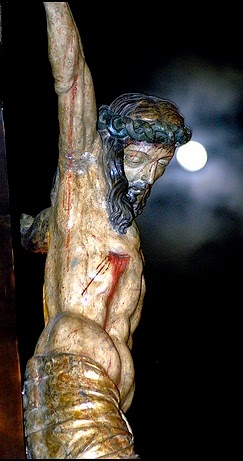
O my dear Redeemer! well do I recognize in these Thy wounds, and in Thy lacerated body, as it were through so many lattices, the tender affection which Thou dost retain for me.
Since, then, in order to pardon me, Thou hast not pardoned Thyself, oh, look upon me now with the same love wherewith Thou didst one day look upon me from the cross, whilst Thou wert dying for me. Look upon me and enlighten me, and draw my whole heart to Thyself, that so, from this day forth, I may love none else but Thee.
Let me not ever be unmindful of Thy death. Thou didst promise that, when raised up upon the cross, Thou wouldst draw all our hearts to Thee. Behold this heart of mine, which, made tender by Thy death, and enamoured of Thee, desires to offer no further resistance to Thy calls. Oh, do Thou draw it to Thyself, and make it all Thine own!
Thou hast died for me, and I desire to die for Thee; and if I continue to live, I will live for Thee alone. O pains of Jesus, O ignominies of Jesus, O death of Jesus, O love of Jesus! fix yourselves within my heart, and let the remembrance of you abide there always, to be continually smiting me, and inflaming me with love.
I love Thee, O infinite goodness; I love Thee, O infinite love. Thou art, and shalt ever be, my one and only love. O Mary, Mother of love, do thou obtain me love.
Good Friday - 2016
 Torch of The Faith News on Friday 25 March 2016 - 10:24:53 | by admin
Torch of The Faith News on Friday 25 March 2016 - 10:24:53 | by admin
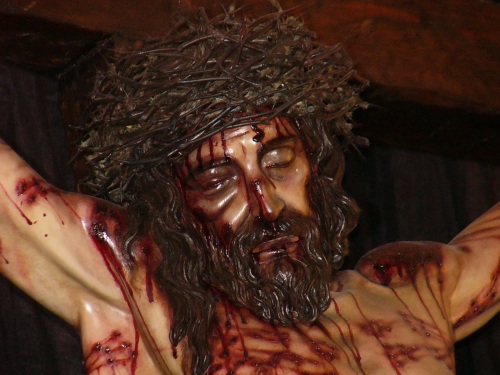
Philippians 2:8: He humbled Himself, becoming obedient unto death, even to the death of the cross.
This is a day of Fasting and Abstinence in the Catholic Church. The Sacred Liturgy today is particularly solemn and takes us into, and through, the saving events of Christ's Passion and Death.
Our Lord Jesus Christ has loved us unto death on the Cross. Today, the Church gives us a special opportunity to enter into His unfathomable mercy and love for each and all of us. Let us enter into that love, by sincere repentance for our sins, by making a good Confession and by making acts of charity towards others out of love for Him.
If you have not been to Confession, or even to church for a long time: please, do not be afraid. It is Our Lord Himself Who prompts you to repentance and waits to forgive and heal you in the person of the priest in the confessional. Confession has helped us so much. Hurry home to be welcomed by Jesus this Easter.
A Blessed Day
How much we need Good Friday in our lives! As we reflected last year, Great Britain has changed dramatically in recent times.
In our parents' day, huge numbers went to church on Good Friday, the shops were closed and the radio stations played sombre music. Even many of those who did not go to church ate fish and acted soberly.
When we were young adults, the Catholic churches were still packed for the Easter Triduum and most of the shops remained closed.
Gradually, the shops and shopping centres began to open up for the day.
In 2014, a lad who works in a bookmakers' shop on Merseyside was saying that his company was forcing workers to work on Good Friday, for the first time ever. Although he was not a Christian, he recognized the cultural significance of the loss of the ''bank holiday''.
Good Friday in England is now typified by the bustling trade going on in bookmakers, pubs, shops and supermarkets; whilst attendance at the liturgies in many places is in free-fall.
There is also an increasing attempt to eradicate Easter, at least in its religious sense, from the culture.
Although there continues to be a roaring trade in chocolate eggs, flowers and good food, many of the new diaries for 2016 were sold without Good Friday or Easter Sunday being marked in them. Numbers of local councils have renamed the Easter Break in their schools as Spring Break; and have even postponed the usual two-week school holidays, so that they do not start until the week following Easter Sunday. As my barber lamented last week: ''The Easter weekend was always right in the centre of your two-week Easter holidays as a kid!''Â
Even for those who never darkened the door of a church, the long weekend running from Good Friday through Easter Monday was always sacrosanct as a national holiday in this country. Yet last year, and again this year, our Green Bin collection for garden waste has been scheduled to take place early on Easter Monday; which would also require us to put the bin out during the evening of Easter Sunday. We did not put our bin out for collection last year; and we won't be putting it out this year either.
As society becomes less and less aware of Easter and all that it signifies and makes possible, it becomes more important for us to enter ever more deeply into the graces of this holy season. St. Paul taught us that we should be wise, redeeming the time, because the days are evil (Ephesians 5:16). Let us not be discouraged, but rather may we console our Saviour in His Passion, thank Him for the gift of faith, ask Him for the grace of a deeper conversion and intercede for those who do not know or love Him. The 3pm Good Friday liturgy gives us such an important opportunity to do all of these things.
We try to highlight Good Friday locally with this window poster:Â Sic Deus Dilexit Mundum translates as God so loved the world (John 3:16).
Reminder: the daily Novena of Chaplets of Divine Mercy commences today in preparation for the celebration of the Feast of Divine Mercy on Low Sunday.
O Holy and Immortal One - Have Mercy on Us!
Holy Thursday - a Night Different to All Others
 Torch of The Faith News on Thursday 24 March 2016 - 15:39:04 | by admin
Torch of The Faith News on Thursday 24 March 2016 - 15:39:04 | by admin
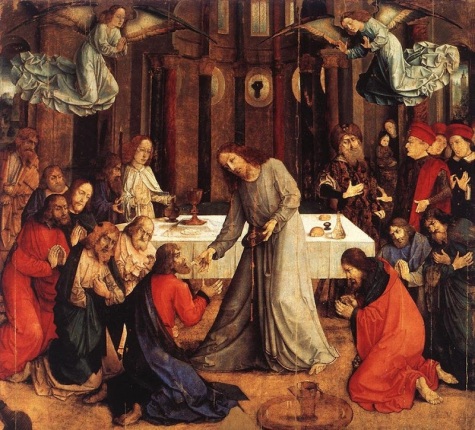
In the Jewish Pesach Seder meal, it is traditional for the youngest member of each family to ask, ''What makes this night different to all other nights?''
As we recall each year, this night is indeed different.
It is the night on which Our Lord Jesus Christ instituted the most Holy Eucharist and the Sacred Priesthood that would offer It down through all the centuries until His Glorious Second Coming.
One of the great mysteries of the Catholic Faith is spoken of in terms of the principle of anamnesis. That gives a name to the mystery by which the Sacred Liturgy makes us present to the saving events and merits of Christ's Life, Death, Resurrection and Ascension and the sending of the Holy Spirit at Pentecost. By opening ourselves to these mysteries we can enter into them and receive their fruits.
On the night of Holy Thursday, the Catholic Church enters into the Sacred Triduum. The three pivotal liturgies of Maundy Thursday, Good Friday and the vigil on Holy Saturday are the beating heart of the Church's liturgical year.
The Catechism of the Catholic Church explains: ''Beginning with the Easter Triduum as its source of light, the new age of the Resurrection fills the whole liturgical year with its brilliance... Therefore Easter is not simply one feast among others but the Feast of feasts, the Solemnity of solemnities, just as the Eucharist is the Sacrament of sacraments (the Great Sacrament). St. Athanasius calls Easter the 'Great Sunday' and the Eastern churches call Holy Week the 'Great Week' (CCC 1168;1169).''
At the end of the Mass of the Lord's Supper tonight, the Blessed Sacrament - Our Lord's Real Presence in the Eucharist, Body, Blood, Soul and Divinity - is solemnly processed to an Altar of Repose. This altar is beautifully adorned with candles for silent prayer and veneration.
We've realised that we ''goofed'' a bit last year, when the positioning of our photograph of the Holy Sepulchre in St. Giles, Cheadle, seemed to suggest that the Holy Sepulchre in medieval churches was used as an altar of repose on this Maundy Thursday evening. Apologies for that! It seems that it was mainly used the next day - at the end of the liturgies of Good Friday; and again early on Easter morning. These medieval practices are themes we would like to research further.Â
Many churches in medieval Christendom had a specially constructed Holy Sepulchre on the sanctuary for those Good Friday and Easter Morning liturgies. As we said last year, the above image does show the Holy Sepulchre at St. Giles Catholic Church in Cheadle. Known as ''Pugin's Gem'', this church was designed and decorated by A.W.N. Pugin in the Gothic-revival style; and thus incorporated such a fine Holy Sepulchre alongside the sanctuary steps and within a decorative Rood Screen.
Getting back to the time of silent ''watching'' at the Altar of Repose after tonight's Holy Mass of the Lord's Supper: this period frequently lasts from the end of the Holy Mass until Midnight.
This awesome period of silence is one of the most sacred times of the year, when grace is so tangible it seems to thicken the air. I remember years ago, a friend grinning delightedly to me during a breather outside of the chapel and saying quietly, ''He's here, isn't He!''
In this holy time, we are enabled to enter into Our Lord's Hour in Gethsemane. This is a special moment to remain with and console Our Lord in His Passion; and to conform our wills to His, by following the example He gave by making the act of His acceptance of the divine will in His human will: ''Not my will, but Thine be done.'' (In the mystery of the Incarnation Christ has a divine will and a human will).Â
In St. Matthew's Gospel 24:40, Jesus asks His disciples, who had fallen asleep while He prayed in Gethsemane, ''Could you not wait with me for one hour?'' On this sacred night, we are given a unique opportunity each year to make reparation for our own lack of watchfulness by entering into His Hour with love and devotion.
What a grace-filled opportunity this is to receive afresh these words from the Catechism of the Catholic Church:Â ''Jesus knew us each and all during His life, His agony and His Passion, and He gave Himself up for each one of us: 'The Son of God... loved me and gave Himself for me (Gal 2:20). He has loved us all with a human heart. For this reason, the Sacred Heart of Jesus, pierced by our sins and for our salvation (John 19:34), is quite rightly considered the chief sign and symbol of that... love with which the Divine Redeemer continually loves the Eternal Father and all human beings without exception (CCC 478).''
On this night, the Sacred Liturgy of the Catholic Church gives us a particularly important opportunity to receive this Love anew and to respond to it.
May none of us miss this opportunity! Â Â Â
Favourite Calvaries Part 3 of 3
 Torch of The Faith News on Thursday 24 March 2016 - 11:40:27 | by admin
Torch of The Faith News on Thursday 24 March 2016 - 11:40:27 | by admin
We conclude this short series with the following examples of our favourite Calvaries:-
Pantasaph - North Wales
Between 2007 - 2009, we lived in a small village near to the Capuchin Franciscan Friary in North Wales. We moved there to be near to the monastic prayers and to take part in the evangelization team that was then operating from there.
The friary is remarkable in that its central church of St. David was not only designed by T.H. Wyatt and adapted by A.W.N. Pugin, but that it has a quite unique history.
In 1846, Lord Rudolph Fielding, later the 8th Earl of Denbigh, married Louisa Pennant. They were then Anglicans and commissioned the construction of St. David's church in honour of their marriage. When they converted to the Catholic Faith in 1850, the rising church converted with them!
Under Cardinal Wiseman, Lord Fielding took an active part in many charitable enterprises. In 1852, Lord and Lady Fielding established the community of Capuchin Franciscans next to St. David's church; their large friary was eventually completed in the 1860's.
During the 1870's, the monks developed the splendid Stations of the Cross, which still zig-zag up through the forested hillside behind the friary, to this day.
As the above images show, each station is marked by a small way-side shrine, containing a beautiful mosaic to aid contemplation.
In a clearing at the very top of the hill - affectionately known as ''the Mountain'' - is this large Calvary scene. When Lord and Lady Fielding converted, Bl. Pope Pius IX granted an Indulgence to those who devoutly visited this Calvary scene, made the Stations of the Cross, or looked from a distance to the Cross whilst praying a ''Hail Mary'' for the reconversion of England.Â
His Holiness also gave the Fieldings the, then, newly re-discovered relics of St. Primitivus. These sacred relics still repose beneath the Lady Altar in St. David's church.
During the time that we lived in North Wales, we frequently made the Stations of the Cross on Friday evenings in the spring, summer and autumn months. As with our visits to Union Cemetery in Steubenville, Ohio, these visits were often punctuated by visits from the local wildlife: rabbits would frequently dart across our path; and it was typical to witness a majestic Buzzard soaring high over the trees above us.
Most of the times we did those stations, we followed those written by St. Alphonsus de Liguori. These were times of deep peace that also challenged us to a deeper conversion. If you can get hold of, and pray, a set of St. Alphonsus' Stations of the Cross, then we highly recommend them.
Trelawnyd - North WalesÂ
During that blessed 18-months in Wales, we rented a wonderful little bungalow that was tucked into the edge of Trelawnyd village.
Trelawnyd means ''Newmarket'' and the village was given this name around 1700 by a local entrepreneur called John Wynne. He enlarged the village, started a weekly market and introduced new industries. Although his dream had been to develop Trelawnyd into a flourishing town, each of the new industries gradually fell away and it instead remains a peaceful little settlement to this day.
Trelawnyd's old St. Michael's churchyard contains the amazing ''Preachers' Cross'' which is seen in these two pictures. It is a medieval construction, dating back to at least the 14th-Century. The stone cross is reputed to have been used by itinerant preachers passing through the village in days gone by. Although St. Michael's is now an Anglican parish, it was originally founded (with an earlier building) as a Catholic church before 1291. In that time, a number of Welsh churches were named for St. Michael as a symbol of territory being won back for Christ from the devil.
Perhaps the Preachers' Cross also had some connection to the Cistercian Basingwerk Abbey, which was founded up the coast in 1131. The ruins of the abbey are still extant, five centuries after the rapacious Dissolution of the Monasteries by King Henry VIII. There is a small tea-room next to the site and we usually pop over there during the summer months for a cup of tea and a slice of cake! Â
The reverse side of the Trelawnyd Preachers' Cross features an image of Our Lady, standing in prayer at the foot of the cross. It is amazing to stand in that churchyard, praying at the foot of that cross, and remember that it represents at least 7 centuries of Catholic history and faith in the Cross of Our Lord and Saviour Jesus Christ.
Shrine of the Most Blessed Sacrament - Hanceville, AlabamaÂ
During the summer of 2005, we spent a few days on retreat at Mother Angelica's monastery and, then, newly-constructed Shrine of the Most Blessed Sacrament in Hanceville, Alabama.
This life-size crucifix, complete with the marks of the scourging, is found in the open-sided cloistered walkways that surround the main church's central piazza.
It is a deeply moving crucifix to stand and contemplate. Since our visit, a kneeler has been set up to facilitate prayerful contemplation.Â
We could not help but think that, if there were more crucifixes as brutally realistic as this - and these pictures do not do it justice at all - then we might all be a bit less inclined to sin. Surely, in this Year of Mercy, it is about time that we all had some mercy on Jesus.
Conclusion
In this series during Holy Week we have shared some of our favourite Calvary scenes: places that have helped us on the ongoing road of conversion, repentance and healing. As we were about to finish this concluding article, we reflected that, at the end of the day, there is no place like home.
As we said in January 2014, it is important to establish a special place in one's home for prayer. It is also essential to have a blessed crucifix in your main living room and over your bed. We also highly recommend, especially in these days, the wearing of a properly blessed Benedictine Crucifix.
When we got married, we were presented with a lovely Crucifix.
There is a tradition, in south-eastern Europe, for engaged couples to be presented with a blessed crucifix on their wedding day; and for this to become a focal point for family prayer in the home.Â
It is essential for married couples to transcend themselves if their relationship is to survive, flourish and give life. This is especially so in the present cultural situation.
When we used to go around offering marriage preparation catechesis, we always encouraged the engaged couples to invite Jesus Christ into the very centre of their love and relationship.
When we got married in 2002, we found it helpful to give this some practical expression by setting up the little prayer altar, pictured above, in our spare room. The crucifix from our wedding gave us a daily reminder that true love is self-sacrificial. Our Lord on the Cross is the perfect model for both the husband and the bride; and for any children that they are subsequently blessed with. In good times and bad, in sickness and in old age, He will be there to remind them all of the value and meaning of suffering.
This can have a very practical impact on the marriage relationship.
A couple of days after returning from our honeymoon, we had our first row as a married couple. It happens! Not wanting to face each other, we went into different rooms. About 10 minutes later, we each headed to the prayer room to ask for Our Lord's help. That is where we found each other, at the foot of Christ's Cross, and we were reconciled.
It is Jesus Christ Who gives us the example, grace and help to overcome our selfishness, brokenness and sinfulness. Jesus raised marriage to the dignity of a sacrament and He wants to be intimately involved in helping His children to live out this vocation.
As the months went by, we gradually began to spend more and more time in front of that family crucifix. Our prayer corner developed into a little oratory with relics, candlesticks, the Sacred Scriptures, icons and even a fablon roll-on stained-glass window! We began to meet there frequently to pray the Rosary, the Chaplet of Divine Mercy and Novenas. We prepared for Confession in there on Saturday afternoons. In time, it supplanted the TV as the centre of our home. It was even in that place that we discerned the call to sell up and travel to America for a couple of years.
The Catechism of the Catholic Church highlights the importance of setting aside a place for personal prayer: ''For personal prayer, this can be a 'prayer corner' with the Sacred Scriptures and icons, in order to be there, in secret, before our Father. In a Christian family, this kind of little oratory fosters prayer in common'' (CCC 2691).
We highly recommend getting a crucifix blessed and set up in your home for encouragement, prayer and example. The prayer corner can start off small and grow into something more substantial.
Our original one may have been supplanted by this east-facing home altar today; but the central crucifix is still the same one that was presented to us when we got married!
This then, is our favourite Calvary!
May the Cross of Christ be the Royal Road that leads us all home to Heaven.
Favourite Calvaries - Part 2 of 3
 Torch of The Faith News on Wednesday 23 March 2016 - 23:14:57 | by admin
Torch of The Faith News on Wednesday 23 March 2016 - 23:14:57 | by admin
Here are some more of our favourite Calvary scenes:-
Groom - Texas
When we first encountered this gigantic 190ft-tall cross, next to Interstate I-40 on the old Route-66 at Groom in Texas, it was being billed as the ''Biggest Cross in the Western Hemisphere!'' Since then, and inspired by this one, some folks in the town of Effingham, Illinois have erected a similar cross with a height of 198ft. Other crosses in Florida, Finland and Spain also vie for the honour of being the tallest.
Still, standing at 19-stories in height, and with a weight of some 1,250 tons, the cross at Groom is no miniature. As such, it can be seen for around 20 miles. That being said, its vast white structure is dwarfed by the endless blue skies and wide-open spaces of Texas. It is only when you pull up in the car park beneath the cross that you begin to grasp something of its sheer scale.
On the day that we did, in the summer of 2005, a golf-buggy suddenly raced over to greet us. The jolly fellow driving it hit the brakes near our car, but sailed on straight past us. He was laughing infectiously, as he announced that he needed to get his brakes fixed! He gave us some free introductory literature, declared that we were most welcome at the site and then, waving and grinning delightedly back at us, shot off again to greet another car that was just arriving.
The cross at Groom was constructed in 1995 by Cross Ministries as a vehicle for evangelization. The team behind the cross pray that visitors will come closer to Jesus and they take 1 Corinthians 1:18 for their motto: ''For the message of the cross is foolishness to those who are perishing, but to us who are being saved it is the power of God.''
Some 10 million people pass the cross every year on I-40. The site is open 24/7 and every single day, around 1,000 people stop off there. Indeed, during the last 20 years, millions of people have come to visit from all over the world. It is the dream of Cross Ministries to build these crosses all over America.Â
The immense white cross is not the only attraction on site at Groom. There is also a large Calvary scene at the top of a stone stairway.  Â
At night, the white cross and this Calvary scene are floodlit against the dark night sky. With little to no light-pollution out there in Texas, they stand out as a powerful witness to the many drivers who cruise past at all hours on the busy Interstate; being as it is the main through-route across the U.S. in the south-central region.
There is also a full and life-size Stations of the Cross sculpted in bronze and running all around the base of the large white cross. When we were there an Evangelical Christian lady was excitedly filming all of the stations on her cam-corder. Saying that she had never seen anything like this, she told us that she was going to get her pastor to have a set put up in her church. She was amazed when we told her that every Catholic church in the world has a smaller set of Stations of the Cross running around the side walls. ''Really?!'' she gasped.Â
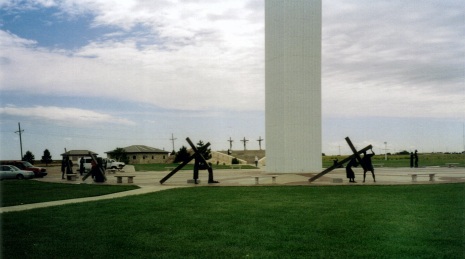
Visitors can take their time to: pray the Stations of the Cross; visit the Empty Tomb and pray alongside a bronze sculpture representing the Angel Gabriel on Easter Sunday morning; view a life-size sculpture of the Last Supper; pray the Holy Michael prayer next to a life-size sculpture of St. Michael the Archangel; view a splendid back-lit copy of the Turin Shroud; pray before a Divine Mercy statue by the ''Fountain of Living Water''; visit the gift shop; and even receive counselling or advice in a suite of counselling rooms.
There is also a special area dedicated to the sanctity of life in loving memory of all the innocent victims of abortion. Â Â
The statue of Our Lord depicts Jesus as though in the Garden of Gethsemane with a small baby in the palm of His hand. We stopped there to pray for all the aborted babies; and for mothers who have had abortions to receive the graces of repentance and healing.
As the background of this photo of Angie kneeling alongside that statue demonstrates, many large semis (lorries to English readers!) pull off the interstate when they see the giant cross at Groom. The lady in the gift-shop told us that some drivers have had conversion experiences and healing by stopping off at Groom during long-haul road journeys.
This is backed up by the Guest-Book page at the on-line website of Cross Ministries. Clearly many folks have been converted, reverted, encouraged, healed and strengthened by visting the Cross at Groom in Texas. We certainly enjoyed and got a lot out of our visit. Whilst there, we also bought a cassette - it was 2005! - of the story of Mr. and Mrs. Thomas who were inspired to build the cross in the first place. We recommend a visit to their website - Â they've even got a link to the Douay-Rheims Bible!
Knock - Co. Mayo, Ireland Â
Angie's parents are Irish and we visit them each year. As they only live about a 25-minute drive from the Shrine of Knock, we always spend at least one day a year at the shrine.
Just next to the old parish church of St. John the Baptist - at the gable of which the holy Apparition occurred in 1879 - is this beautifully crafted Calvary scene.
We always stop off before this Calvary to say a little prayer; and usually to take another photograph for the family album. Those grey clouds look like a fairly typical summer in Co. Mayo! The Shrine of Knock is important for these times and we recommend a visit. If there were more Traditional Latin Masses it would be very Heaven; there are some around in Co. Mayo, but you've got to do some research and be prepared to travel...Â
Little Crosby - MerseysideÂ
The village of Little Crosby on Merseyside is thought to be the oldest extant Roman Catholic village in all of England.
It is historically important, and we personally believe that it is spiritually important for these and future times, because the recusancy of the local squires of the Blundell family kept the flame of the True Faith burning uninterruptedly here throughout the revolution of the Reformation and post-Reformation centuries.Â
The village is centred on the splendid Pugin-inspired St. Mary's Church, has a now-closed convent building and a small parish school, and keeps up various traditions through the seasons of the liturgical year. Although it retains much of the architecture and feel of earlier centuries, it is today used as a through-route by a great many vehicles cutting through from places like Formby and Southport to Crosby. This does mean that, in spite of the small scale of the village, many souls pass the village crucifix every day.
That crucifix, pictured above, was erected in memory of the squire Francis Nicholas Blundell, who passed from this life in 1936.
At its base is found an encouraging quote from the Gospel of St. Matthew 10:32: ''So every one who acknowledges me before men, I also will acknowledge before My Father Who is in Heaven.''
Interestingly, the presence of this large crucifix in the village allows locals and passers-by the opportunity to do just that!
Over the years, we have found it a special place to stop off and say a prayer for the reconversion of England. An American friend from Steubenville visited us one summer and we walked him through the village to point out the cottage where the Holy Sacrifice of the Mass was said from penal times and to visit the village crucifix. We do believe he was mighty impressed!
Lourdes, France - Hillside StationsÂ
During the summer of 1998, I spent a whole month working as a pilgrim-guide for English-speaking pilgrims from places as disparate as Africa, America, Australia, India, Ireland, the Philippines and, of course, the UK. It was a time of immense graces and blessings.
Every morning, after Holy Mass followed by an introductory talk, my duties included leading pilgrims up the Stations of the Cross on the steep hillside above Lourdes. Each of those stations is constructed from a series of life-size bronze-coloured statues. It can be a very moving experience to go up there with pilgrims and I am sure that I received graces for ongoing conversion and repentance during those marvellous days.
Most times we would be joined by a dozen or so ''Pelerin d'un Jour'' (Day-Pilgrims) who were passing through Lourdes as part of a tour of the major Catholic sites of Fatima, Lourdes and Rome during their sojourns in Europe.
I witnessed many ''mini-miracles'' during that month - moments when people received instances of emotional healing and new strength to carry on.
Two of these stick in my mind even now - 18 years later.
One day, an Indian gentleman who was living in London had come to Lourdes to pray for his father who had just died and been buried in London. As he left one of the churches in the town of Lourdes, he bumped into the very doctor who had tended his father in his last moments back in England! He was amazed by this and took it as a sign of God's providential care for his late father and for his own needs in his time of grief.
Gosh, some of those Indian families were holy. They had such a profound love of God and humble respect for the sacred priesthood; and for seminarians by extension. I met a lot of folks from Kerala and they were simply on fire for the Faith! It did the soul good just to meet people like this and listen to their stories.
Another ''mini-miracle'' that I remember involved two women who had come separately to Lourdes from England, without either having ever met the other, in order to recover from troubled relationships that they had been in with abusive men.
As I mentioned earlier, most days I had about a dozen pilgrims from various continents coming up those stations with me. On that day, just those two English ladies came along. They were very broken souls. It became clear to me as a then-young seminarian of just 25-years of age that there was a limit to the help that I could give, aside from prayerfully leading the stations and encouraging them. (Newer readers might need to know that I became ill in the modernist atmosphere in the seminary and eventually left. Just over a year after leaving, I met Angeline and we got married two years after that in 2002. We established Torch of The Faith together in 2008).
What was amazing was that, from the time I gave the introductory talk, these two had begun to form a genuine friendship. At the end of the Stations of the Cross, I had a real sense that God was working to help these ladies to help each other; and that I, having done the bit assigned to me, needed to simply get out of the way and let the Holy Spirit do the rest. When they said ''goodbye'' to me after the Stations of the Cross, and headed away for a coffee together in a local cafe, there was a real joyful sense of God's caring presence working in this new friendship. It is hard to put into words really.
Anyway, what I did put into words most days relates to the picture of the Calvary scene above.
If you look closely, you will notice that the Good Thief - St. Dismas in Catholic Tradition - is looking across to Our Blessed Lord. On the other hand, it is chilling to observe the Bad Thief looking away angrily from Christ and dying unrepentant.
I used to ask the pilgrims to consider that scene prayerfully for a few moments; and to grasp both the beauty of repentance and the awful horror of sin and, even worse, of unrepentance.
I used to remind the pilgrims that we must pray for the grace of final perseverance. Just a few months ago, I read somewhere that a saint - I can't recall who now! - taught that we must beg God every day for the grace of final perseverance. There is a prayer to St. Joseph for a Happy Death which we would highly recommend in relation to that.
Those many days of going up those high Stations of the Cross with pilgrims in Lourdes were among the happiest days of my life. The Calvary at the top is therefore one of my favourites anywhere.
God willing, Angie and I will share our final ''Favourite Calvaries'' with you in part 3! Â
Hilaire Belloc in 1929: The Masses of Europe are Not As Yet Aware
 Torch of The Faith News on Wednesday 23 March 2016 - 11:59:56 | by admin
Torch of The Faith News on Wednesday 23 March 2016 - 11:59:56 | by admin
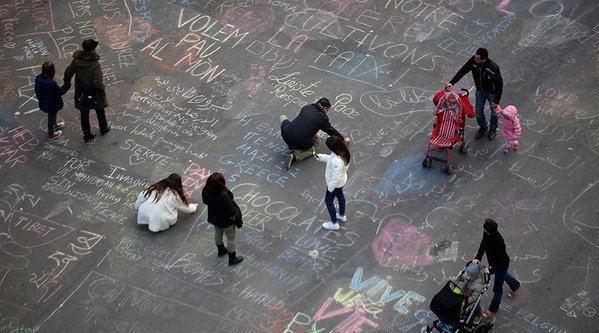
Post-modernity responds: People scribble their responses to the latest existential acts of terror.
Before reading further, we invite readers to pray a ''Hail Mary'' for the victims of the attacks in Brussels.
On 16th November last year, we critiqued the fact that, in the wake of the dreadful attacks in Paris, so many people were deriving ''great comfort, hope and peace'' from a pianist playing John Lennon's nihilistic anthem Imagine, outside of the doomed Bataclan theatre.
At the time we lamented the fact that this episode, taken together with the playing of jazz-music, the relativistic and uncertain responses of so many Catholic prelates who failed to even mention Our Lord Jesus Christ, and the pointless violence itself, were emblematic of the fact that our civilization is circling the drain.
And now, in the middle of Holy Week 2016, Europe bleeds once again. How much more decadent those rupture-inducing words of Cardinal Walter Kasper at the weekend now appear.
It is becoming almost a custom now to light up famous landmarks in the colours of the flag of the latest victims, to declare oneself ''Je suis'' this or that, to post up heartfelt messages and hold up handwritten phrases on social media, and to basically proclaim that, although the terrorists have guns and bombs, we have flowers.
As the above-picture shows, people in Brussels had already taken to chalking messages like ''My religion is peace!'' on the pavement of the Place de la Bourse yesterday.
Rome burns and the masses fiddle...
Lessons from History
About 9 years ago, I got into reading the works of both G.K. Chesterton and Hilaire Belloc. Although overlooked in contemporary society, these writers have proved as prescient as they were entertaining to read.
The late and great Fr. John Feeley, who died a few years ago at the age of 95, used to offer the Traditional Latin Mass, each Sunday afternoon, in his parish of Our Lady of Victories and St. Alphonsus in Lutterworth. We remember him preaching on the fact that Chesterton and Belloc had been prophetic on so many themes. He pointed out that, although he first read them as a boy of 15 in Lancashire, he had never forgotten their warnings about the coming of a society marked by unnatural crimes.
Another theme which the great ''ChesterBelloc'' got so right related to the fact that Europe owes its historical development to the Catholic Church.
The sincere student of history is forced to acknowledge that this assertion holds true in the inter-related fields of religion, philosophy, family-life, civic-life, healthcare, law, prayer, social cohesion, trade, art, architecture, culture, music and military organization.
In common with such careful historians as Christopher Dawson, these wise men recognized that the survival of Western civilization depended on the recovery of the Catholic Faith at its foundation and heart.
Belloc was so far ahead of his time that he penned an article in 1929, fully 87 years ago, which was scoffed at by many as being quite preposterous. He wrote:
Survivals and New Arrivals (1929)
There remains, apart from the old Paganism of Asia and Africa, another indirect supporter of Neo-Paganism: a supporter which indeed hates all Paganism, but hates the Catholic Church much more: a factor of whose increasing importance the masses of Europe are not as yet aware: I mean the Mahommmedan religion: Islam.
For centuries the struggle between Islam and the Catholic Church continued. It had varying fortunes, but for something like a thousand years the issue still remained doubtful. It was not till nearly the year 1700 (the great conquests of Islam having begun long before 700) that Christian culture seemed - for a time - to be definitely the master.
During the 18th and 19th Centuries the Mohammedan world fell under a kind of palsy. It could not catch up with our rapidly advancing physical science. Its shipping and armament and all means of communication and administration went backwards while ours advanced. At last, by the end of the 19th Century, more than nine-tenths of the Mahommedan population of the world, from India and the Pacific to the Atlantic, had fallen under the Government of nominally Christian nations, especially of England and France.
On this account our generation came to think of Islam as something naturally subject to ourselves. We no longer regarded it as a rival to our culture, we thought of its religion as a sort of fossilized thing about which we need not trouble.
That was almost certainly a mistake. We shall almost certainly have to reckon with Islam in the near future. Perhaps if we lose our Faith it will rise.
Lessons which need to be re-learned - and quickly!
What can be more emblematic of a culture that has lost faith not only in God and Catholic Truth but in its very self, than the spectacle of post-moderns burying their heads in the sand, so to speak, by playing with lights on buildings even as radical Islam rises up to destroy their civilizaton. Indeed, even as churches are desecrated, transport hubs are blown to pieces and women are raped and molested in increasing numbers, by elements within the surging numbers of immigrants fleeing from the destabilized countries of the Middle-East.Â
And, whilst some adults chalk feel-good slogans on sidewalks, disturbing numbers of young people respond by instead signing up for radical right-wing vigilante groups to respond to so-called Islamic no-go areas in the disintegrating cities of Europe.
Of course, neither of these extremes is the correct response. When you have taken a wrong turn somewhere in a journey, you need to retrace your steps to the point when you knew where you were.
Europe once knew that it was Catholic. She understood that her culture was underpinned and had taken shape through the fertile roots of Catholic Christendom. Even the concept of individual rights and liberties, though perverted through freemasonic and Enlightenment influences, would not have taken shape, as it did, without the foundational environment of Catholic Christendom and her Scripture-based thought forms.
Before yesterday's evil atrocities in Brussels, there were a couple of news items from the last week or so that had caught our eyes. Both were hugely symbolic of where we are at culturally speaking.
The first related to the darkening of Europe in honour of the globalists' Earth Hour. Although the Vatican authorities symbolically plunged St. Peter's Basilica into darkness, towns in Sweden would not extinguish their lights, for fear of public safety in light of the numerous attacks on women carried out by elements within the large numbers of immigrants.
The other news related to the deeply troubling fact that schools in Britain are no longer to be expected to teach about key moments in British history - such as Magna Carta, the leadership of Winston Churchill or the two World Wars - whilst they have to learn about ancient civilizations, including early Islamic civilization.
Christ is the Answer
Neither right-wing political extremism, nor post-modern indifferentism, have the answers to the grave crises now afflicting the remains of our Western civilization.
In conclusion, let us reflect on some important words that we have already quoted here a few times in recent months. They are those of Pope St. Pius X in Quas Primas: ''When once men recognize, both in private and in public life, that Christ is King, society will at last receive the blessings of real liberty, well-ordered discipline, peace and harmony'' (QP 19).
We would suggest that this is a forgotten lesson which Europe needs to speedily re-learn.
Favourite Calvaries - Part 1 of 3
 Torch of The Faith News on Tuesday 22 March 2016 - 17:31:30 | by admin
Torch of The Faith News on Tuesday 22 March 2016 - 17:31:30 | by admin
One of the great consolations of Catholicism is the mystery of God suffering for and with us. It is such a comfort to be able to look at, and even to embrace, a crucifix during times of darkness and suffering. This being Holy Week, we thought we would share some of the Calvary scenes that have most helped us. They are presented in alphabetical order.
Birmingham Oratory
When we were involved with the formation of catechists through Maryvale a few years ago, we often used to go to Holy Mass at the Birmingham Oratory.
Near to the rear entrance door is this beautiful crucifix; before which we used to pray for guidance. Angie often lit candles there. It's hard to convey, but we used to experience great peace each time we prayed before this particular image.Â
When we came back north, we took a photograph to remember the crucifix by. When we loaded it up to the lap-top, we were struck by the fact that Our Lord's garment and Crown of Thorns had a golden appearance. They don't in the original.
The bruising on Our Blessed Lord's knees is particularly touching.
Santuario de Chimayo - New Mexico
Nestled in the foothills of the Sangre de Christo mountains, about 25 miles to the north-east of Santa Fe, New Mexico, stands the famous Santuario de Chimayo. We were blessed to be able to visit this shrine during the summer of 2005.
This historical Catholic shrine is known as the ''Lourdes of America'' because of the many healings which are attributed there to Our Lord Jesus Christ.
One of the oral traditions at the heart of the Chimayo story, recounts that Don Bernardo Abeyta, a member of a local penitential society, was praying and performing penances around the local hills one Good Friday evening.
Don Abeyta is said to have seen a light springing from one of the hills near to the Santa Cruz (Holy Cross) river. When he got to the spot, he realized that the light was coming from the ground and Don Abeyta began to dig with his bare hands. He soon unearthed a large wooden crucifix. Leaving it there, he went to gather some local men to come and make acts of veneration before the holy image. The local Catholic priest, Fr. Sebastian Alvarez was notified and he led a procession to the site.
The priest raised the crucifix and led the joyful procession all the way back to the church. As the people prayed, he inserted the cross into a niche on the High Altar. However, the next morning the crucifix was gone. It was found to be once more on the slope of the hill. After three church processions, disappearances and rediscoveries on the hillside, it was decided that a chapel should be constructed on the site of the finding. This is the site of the Chimayo shrine today.
In a side-room next to the main chapel at Chimayo is found the ''el pocito'' (the little well). This is believed to be the site where the Miraculous Crucifix of Chimayo was originally found. Indeed, this room may actually be the original chapel from 1814.
For many decades, pilgrims have taken the ''tierra bendita'' - blessed earth - from this little well. This pious custom started when people began to claim healings at the site.
Although, unlike Lourdes in France, the Catholic Church has never officially approved any of these miracles, Chimayo is a Catholic place of pilgrimage under the jurisdiction of the Archdiocese of Santa Fe. Numerous crutches, walking sticks and wheelchairs have been left behind as signs of healing and thanksgiving.
The focus of the Chimayo chapel is the Tabernacle at the centre of the east-facing High-Altar. This depicts a beautiful golden image of the Sacred Heart of Jesus. Above this, is the Holy Crucifix of Esquipulas.
The Crucifix at Chimayo is truly a santa cruz - a holy cross! The time that we spent kneeling at the simple hand-carved and painted altar-rails is remembered by us as one of the most peaceful times that we have shared together on this earth.
How beautiful it was to kneel together so close to the flickering red sanctuary-lamp and see the Sacred Heart image there before us; reminding us of the Real Presence of Jesus Truly Present in the Blessed Sacrament. How marvellous it was to then gaze up to the Miraculous Crucifix and be reminded how much Christ loves each and all of us; and how He invites us to repentance and the nourishment and rest of Holy Communion.
Grace seemed so thick in the air at that place, that it seemed to alight on your very eyelashes.
The Holy Cross at Chimayo reminds us that it is not so much what we do, but Who Christ Is; and what He has done and is doing that matters most of all.
In the desert, resting at the foot of the Cross, we again found the waters of life.
Crosby Beach - Merseyside  Â
Regular readers will probably have guessed that Crosby Beach, where the River Mersey meets the Irish Sea a few miles to the north of the city of Liverpool, is one of our favourite places.
Fair play to the various local Christians who erect three crosses - and various texts from the Sacred Scriptures - there every Good Friday, ''for people to meet Jesus'' through their work. It is quite impressive to stand and pray there, with the wind blowing in your face, during the Easter weekend each year. The presence of those three crosses each year is a particularly powerful witness in these days of secularization.
On Easter Sunday morning, the central cross is draped with a white cloth to depict the burial clothes after the Resurrection. There is something very special about seeing this blowing in the coastal breeze.
We've drawn from the presence of those crosses to tell local observers about the Sacred Easter Triduum too!
Fr. Dean Hartnedy's Shrine - Steubenville, Ohio
Strange as it may sound, Union Cemetery in Steubenville, Ohio, is such a pleasant parkland-type of place that many locals, as well as faculty and students from Franciscan University, often go there for walks in the fresh air. Many students meet up there to talk, think and plan. We even know a married couple who went there for their first date. The man's wife used to laugh: ''He asked me to the cemetery for our first date and I still married him!'' Indeed, they went on to have, and homeschool, several children.
As well as the parkland feel of the place, we were attracted by the presence of blue jays, squirrels and remarkably tame deer among the graves, trees and walkways. (English readers might enjoy ''Googling'' the word ''Blue Jay'' to see just how beautiful they really are).Â
During the period that we lived in Steubenville between 2004-2006, we used to walk around Union Cemetery, about twice a week, in the spring, summer and autumn months. It was a good reminder of the brevity of this life; and the bigger picture of things in God's providence. Such thoughts were probably encouraged by the fact that our graveyard meanderings invariably ended with a few minutes of prayer at the foot of Fr. Dean Hartnedy's hilltop shrine. Fr. Hartnedy served in St. Peter's parish and established the mission church of the Holy Name of Our Divine Lord in the late 1800's. He died and was buried in 1912.Â
The stone shrine not only included Dean Hartnedy's mortal remains, but was encircled by the graves of numerous other Catholic priests, who had served around Steubenville over the years. Perhaps it was the presence of all those priests, maybe it was the prayers of various unknown students down through the years, perhaps it was just the ambience of the place; but there was a very tangible peace there.
When you are 4,000 miles from home, on the far side of the Atlantic Ocean, it can be very reassuring to look up to Our Lord on a life-size crucifix, like the one atop Dean Hartnedy's stone chapel.
You sort of felt Christ's care and concern for you there; as He looked down on you from up above. And with that perspective, you sensed just a tiny bit of what it might have been like to stand beneath Christ's Cross. That crucifix was powerful; it could call forth love from your heart. We went there with a few of the problems that we encountered in those years spent so far from home, family and close friends.Â
That little stone chapel, with its rooftop crucifix was so special to us that, on both of the Good Fridays that we spent in America, we went up there after the 3.00pm liturgies and carefully placed a rose through its metal gated entrance.
After almost 10 years, it still remains in our memories as one of our favourite places on this earth.
The Cross of Christ, and the grace and example that He gives from it, remain essential foundations for the strengthening of any Christian marriage.
God willing, we'll share a few more of our favourite Calvaries in parts 2 and 3!
Our Lady of Banneux - Pray for us!
 Torch of The Faith News on Tuesday 22 March 2016 - 12:12:12 | by admin
Torch of The Faith News on Tuesday 22 March 2016 - 12:12:12 | by admin
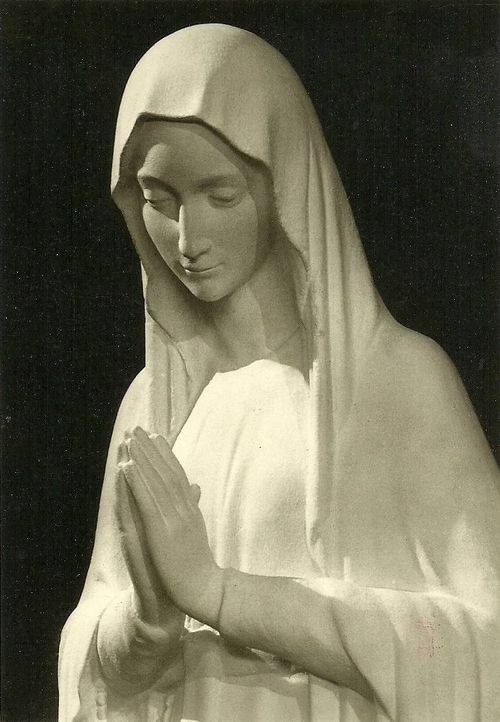
Our Lady of Banneux, Belgium: ''I come to relieve suffering.''
We pray for all the victims of the attacks in Belgium.
We commend them and all of their loved ones to the maternal care of Our Lady of Banneux.
Sorrowful and Immaculate Heart of Mary - Pray for them.
Sacred Heart of Jesus - Have mercy on them.
Now Lessons on ''Transsexualism'' for 4-Year Olds in a School Named St. Mary the Virgin...
 Torch of The Faith News on Monday 21 March 2016 - 17:24:04 | by admin
Torch of The Faith News on Monday 21 March 2016 - 17:24:04 | by admin
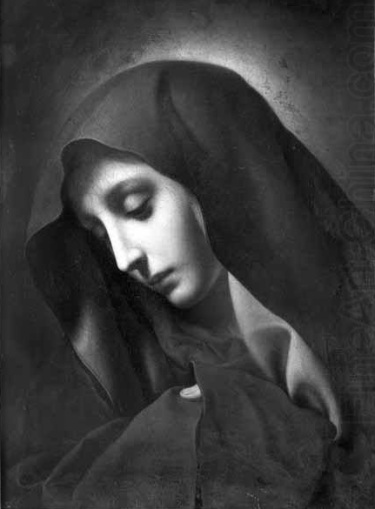
Lamentations 1:12: ''O all ye that pass by the way, attend, and see if there be any sorrow like to my sorrow.''
Sacred Heart
It is now 11 days since we first reported that Miss Carrie Morrow, a Headteacher in the Archdiocese of Liverpool, had allowed a group of adults to perform a drama promoting homosexual relationships - a performance which even included the portrayal of a same-sex ''marriage'' ceremony - to the young children in Sacred Heart ''Catholic'' Primary School in Atherton. As we said at the time, local parents only found out after the event that this was even happening.Â
It is fully 10 days since we reported the development in the story, when it was announced that Miss Carrie Morrow, and the school, had been awarded an ''LGBT Rainbow Flag Award'' from the Proud Trust. This was awarded because the school had allowed the play to take place, taught the young children ''when it is acceptable to use the word ''gay'' and involved them in the creation of art work to promote Wigan's ''Gay Pride'' day. All of this was described as ''tackling homophobia''.
As we said in both of those reports, parents who complained were dismissed as a ''homophobic minority'', mocked with the same terminology by various media outlets and investigated by local police for ''hate crime''...
It is also 5 days since we pointed out that CitizenGo had launched an on-line petition calling for Archbishop Malcolm McMahon to take appropriate disciplinary action in this case. When we checked just a few minutes ago, the number of people who had signed up to that petition had reached 6,270.
And yet, after all this time, outside of this anonymous petition, the public response of the Archbishop, bishops, priests, deacons and laity of the Archdiocese to this very public transgression of natural law, divine law, canon law, and the various post-Conciliar documents, which govern Catholic education and affirm the rights and duties of parents, has been absolutely zero... zilch... nada... nothing!
Further Developments...
On Friday afternoon, the Action Transport Theatre - the group which performed the homosexualist drama at Sacred Heart School in Atherton - put on another play for young children in St. Helens Central Library. It was billed as being suitable for children as young as 5 years of age. The library has promoted the event via Twitter.
St. Mary the Virgin
Now The Christian Institute reports that the Anglican primary school of St. Mary the Virgin, in Hartfield, East Sussex, is going to host a day on ''transsexualism'' for children as young as four years of age. The day is said to include classes designed to ''empower lesbian, gay, bisexual and trans young people.'' During this event, small children will be encouraged to ''explore'' their sexuality.
Although several parents have vowed to keep their children out of school on the day in question, ''Ms.'' Emma Maltby, the school's headteacher, defended her actions by suggesting: ''As part of the national curriculum, we spend time talking to the children about British values of tolerance, respect and celebrating differences.''
One of the mothers who is keeping her child away from the school on that day has stated: ''Some parents have announced their intention to keep their children from school on at least one day'' because they ''feel the welfare of their children is under threat.''
No Coincidence...
I was speaking to a good priest on Saturday evening and he agreed with me, that it can be no coincidence - at least at the spiritual level - that the first two English primary schools at the centre of the promotion of homosexual ideology to small children would be dedicated to the Sacred Heart of Jesus and to St. Mary the Virgin...
Our Lady of Fatima showed the young seers a vision of Hell and warned them: ''People must amend their lives and ask pardon for their sins. They must not offend Our Lord any more, for He is already too much offended!
The whole thing represents a bridgehead of the LGBT movement into Catholic and other Christian faith schools in the UK. The reaction, or rather the non-reaction, of Church authorities to this opening will set a precedent which will be quickly exploited.
''Ms.'' Maltby's use of the ''British Values'' curriculum to defend this event called to mind the history of some of my family members:
Two of my nan's brothers were drowned when their ship was torpedoed by a German U-Boat, my uncle risked his life night after night, sitting in the most dangerous seat in the house as a tail-gunner in an Avro Lancaster Bomber, my grandad helped to construct the local Anglican parish church and my parents brought us up to worship God, respect our neighbours, act as responsible members of society and seek the truth. For years my Dad even had a framed picture of the Queen in the living room and the Queen Mother in the dining room! I can just imagine what these family members would have made of the notion that promoting homosexuality and transsexualism to infants was somehow an aspect of British values...
More than that though, we know what Our Blessed Lord makes of it all; for He has told us in Sacred Scripture: ''But he that shall scandalize one of these little ones that believe in me, it were better for him that a millstone should be hanged about his neck, and that he should be sunk in the depth of the sea'' (Matthew 18:6).
And so, we must reiterate our call to Archbishop Malcolm McMahon to take disciplinary action in the case of Sacred Heart Primary School in Atherton.
Edmund Burke: The only thing necessary for the triumph of evil is that good men should do nothing.






